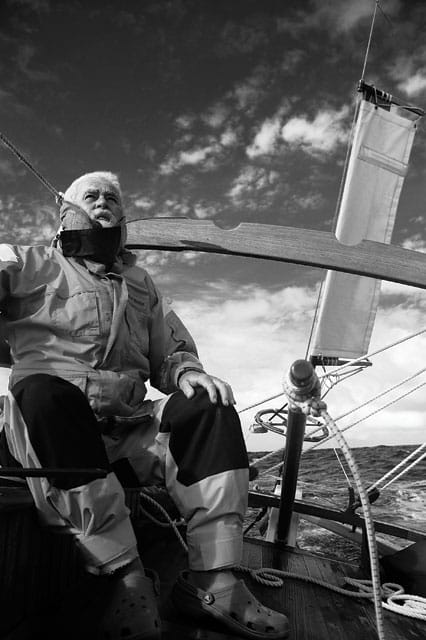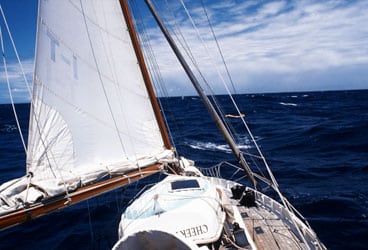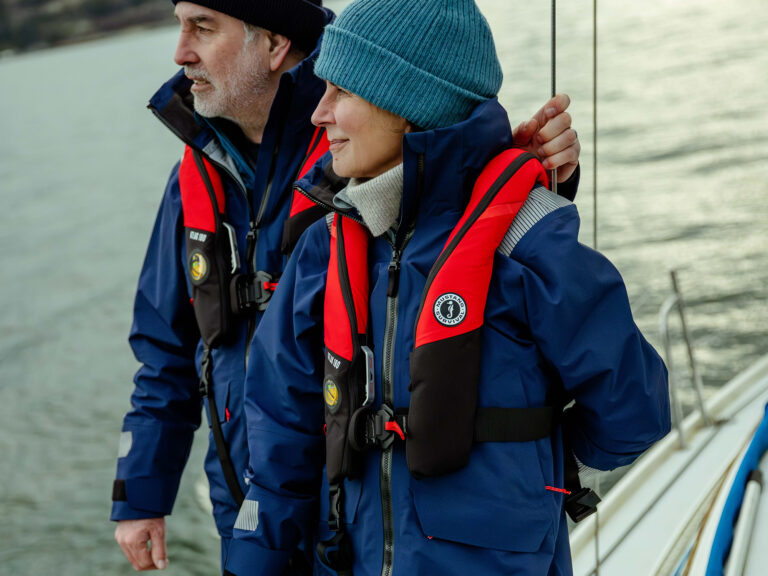
Larry Pardey
A line of magnificent, fire-spouting thunderstorms marches along the western horizon. The gigantic clouds seem to boil and climb toward the heavens, creating constantly changing images in the moonlit night. There are stars overhead, and for a few miles around us, the skies are clear. For the moment, I can sit comfortably in the companionway to enjoy the lightning’s pure power as we reach away from Australia’s reef-infested shores.
I’ve already rehearsed the steps I’ll take if one of the squalls closes in. My open foul-weather jacket is right next to me. Since the mainsail is the hardest one to control, at the first drop of rain or the first sign of a wind shift, I’ll don my jacket, go forward, and drop it aboard our 29-foot Taleisin. If the wind continues to increase, I’ll release the jib halyard and douse the 100-percent lapper using the downhaul. If I’m a bit late, I’ll let the sail fly and flail for the few seconds it takes to release the halyard, let it drop into the water, then pull it back on board. I’ve played this game twice in the last two days.
My husband, Larry, and I have been sailing on the edge of a front teetering between a retreating low-pressure area and an advancing high. Light winds interspersed with squalls have plagued us as we reset our sails 20 times a day to take advantage of each wind shift to work southeast. Having left the Australian coastal town of Mooloolaba, in Queensland, and ultimately bound for our home on the New Zealand island of Kawau, on this first leg in the Tasman Sea we’re determined to reach Lord Howe Island to rendezvous with friends. We’ve dropped the sails 10 times to stop them from slatting during one-hour calms; when the breeze filled in again, we discussed our tactical choices. Should we sail due south to find the southeast winds predicted to fill in soon, or should we head straight for our goal on the northeast breezes we have for part of each day?
Earlier today, I struck the mainsail when whitecaps appeared ahead of a squall-like cloud. I was glad there were no battens to hang up as I pulled on its luff rope and watched the sail fall into the lazy jacks, even though the boom was vanged and prevented for a beam reach. But those whitecaps prefaced a lovely 15-knot breeze. The accompanying cloud dispersed but a few brief showers, then paraded grandly toward the Australian coast. So, without sheeting home the boom or heading into the wind, I’d rehoisted the main, its claw-type slides moving easily along the external mast track even with the wind pressing the sail against the rigging. Since then, we’ve been booming along, fast-reaching under mainsail, staysail, and lapper, with decks dry and the breeze right on the beam. We’ve decided to compromise on our course, reaching off 15 degrees just in case the southeasterly greets us before we reach Lord Howe Island.
As I watch from the companionway, I consider yet another reason we’ve resisted mounting a dodger on Taleisin. Without one, half of me sits in the friendly, orderly cabin where Larry, sleeping soundly, is within easy shouting distance should I need his help. At the same time, I’m already halfway outside, so there’s no reason not to check a line or trim a sail. Without the dodger, I can study the whole horizon, estimate the track of each squall, and watch stars appear behind each trailing skirt of clouds. Tonight, I contemplate how our amidships galley and aft watch seats make the dodger less important to us. We can cook without fear of spray or wind dousing the stove; we can remove our foul-weather gear in the dry space just below the companionway, safely away from the person working in the galley.
Tonight, half in and half out, I hear a pod of dolphin before I see them. Sonar-like squeals echo inside the boat, and bioluminescent flashes spread like green lightning to each side of Taleisin. The rhyme I’d read years ago leaps to mind: “When the sea hog leaps and slaps its tail, tall ships soon wear short sails.”
This evening, though the dolphins cavort beneath the boat in crisscrossing streaks, they don’t leap clear of the water. Twenty years earlier, I’d been on watch as our 24-foot Seraffyn carried us south across the Gulf of Papagayo off the west coast of Nicaragua. We were running fast under reduced canvas. The dolphins came in massive numbers, leaping and slapping. When their spray flew across the cockpit, I was glad I was already clad in foul-weather gear. I swear I saw one dolphin leap across our 7-foot-long bowsprit, through the gap between our inner and outer forestays. Larry thinks the moonlight fooled me. But two hours after the visit from those high-flying “sea hogs,” we lay hove to on a parachute sea anchor in fierce winds and seas.
Back in the present, it’s hard to gauge which way the squalls are moving. Instead of careening downwind, as we expected, they seem to be moving across the breeze, but very slowly, as if driven by whim rather than wind. They change position so sedately that they seem almost benign. But it was only three weeks ago and 600 miles north of here that a seemingly slow-moving line of squalls caught the 55-foot sail-training vessel Marymuffin (the ex-racer once called Ragamuffin) and knocked her flat.
Marymuffin‘s crew—five trainees and a skipper—were caught unaware. The knockdown blew out two sails; the cockpit-sole engine-room hatch flew open and water poured in. Her crew managed to claw down the mainsail and get her back on her feet, but the engine was out of commission, and the boat was blown toward the breakers pounding on the reefs of the Capricorn Group. The 60-knot winds, gusting to 65, made feeding the mainsail’s boltrope into the mast groove a daunting task. A small storm jib helped get Marymuffin under control. But as her skipper later said, “We didn’t get her moving forward until we could actually see the breakers on the reef less than 400 yards to leeward.”
On our trip that preceded this one, we were 75 miles to seaward of Marymuffin and headed in the opposite direction when that earlier squall line hit. It was my watch, and a girlfriend’s word of warning came to mind as I listened to the 0500 weather report that mentioned “northerly winds easing, southeast winds proceeded by squall line with gusts to 35 knots.” Sandy Peterson and her partner, Andy, cruised extensively on the 57-foot S&S sloop Jakaranda before settling in Australia. As we parted ways after an enjoyable rendezvous, Sandy said, “If reports say a southerly change is imminent, drop all sail for any squall line you see. We got caught in a 50-knot blow out of the blue last November when we were headed down through these reefs.”

| |With a deeply reefed mainsail driving our 29-foot cutter, Taleisin, on a close reach into a lumpy seaway, the miles passed quickly if not comfortably on yet another shorthanded passage. We changed sails literally dozens of times over the course of the eventful voyage to maximize our speed and efficiency in the ever-changing wind and sea conditions we faced.|
As a highly conservative sailor, I began dropping the sails we’d used to reach southeastward as soon as I saw that previous squall line, even though I knew it was almost 3 or 4 miles away. With the jib securely lashed, I felt a bit foolish to be sailing under such reduced canvas. But the first gusts hit within 10 minutes, and I got thoroughly soaked striking the mainsail and stashing the staysail. Within two hours, we lay with reasonable comfort while the parachute sea anchor and storm trysail held us at 45 degrees to the howling storm winds and incredibly steep seas caused by the stiff southerly opposing the swift East Australia coastal current.
Later, the weathermen at Brisbane revealed a major distinction between the weather system that spawned that vicious line of earlier squalls and the one causing these on our voyage to Lord Howe. Three weeks before, an unseasonable low-pressure system—in advance of the tropical-cyclone season—stalled and deepened 180 miles north of a ridge of high pressure that lay over Australia’s tropical coastline. The pressure differential between the two was more than 34 millibars—a difference of almost 1 millibar for every 5 miles. To equalize that pressure, the winds swooping in often reached 65 knots. From a careful study of the weather maps two days before we set sail for Lord Howe, plus updated forecasts, I knew the difference in pressure between the low passing over us and a high following 500 miles behind was less than 24 millibars (or less than a millibar of change every 20 miles). So the chance of encountering really strong winds was limited; if we did, they’d probably last only a short while.
Even so, halfway through my watch, I go forward and uncleat the coils of the main and jib halyards, then lay them on deck ready to run freely if and when I release them. As an extra precaution, I assure myself that each of the halyard ends are well secured with stopper knots through eyebolts at the base of the mast so I can forget about them when I do cast them off. I check the jib tie-downs on the bowsprit to make sure they’re ready. I inspect the downhaul line. A particularly ferocious burst of lightning appears from a squall that seems to loom over us only a mile or so away. But I count the seconds and after I reach “nine one-thousand” and still hear nothing, I assure myself that the threat is at least a dozen miles away.
The last few minutes of my three-hour watch pass quickly as I check the log, advance our position on the chart, then prepare a light snack for Larry. There’s a special feeling of accomplishment, a sense of having been in control of not only my fate but also of Larry’s and our boat’s, that comes from watching a squall line and from appreciating the difference between real danger and prudent vigilance, knowing that if my timing is right, the worst-case scenario might mean a little extra work on my behalf. For all their potential might, I know these squalls will delay us only if we need to heave to as they pass or if the winds are light in their wake. I enjoy this feeling. But when Larry climbs out of his bunk and joins me in the cockpit, where I can point out the squalls and give him a status report, I’m glad to pass along the duty to watch safely over us to him.
“Pretty impressive sight,” he calls down as I climb into the bunk. “Where’s the badge of responsibility?”
“The flashlight is next to the leeward sheet winch,” I call back. “Try and sail out of these dumb squalls.”
A rumble of thunder echoes through the boat, and I hear Larry zip up his foul-weather gear. He’ll not be as fortunate on his watch. Rather than being merely a spectator to nature’s grandeur, he’ll be a wet and active participant. As I drift off to sleep, I hear the mainsail coming down the track. That’s the last thing I remember for three hours: I sleep soundly through two squalls and a pair of wind shifts, secure in the knowledge that while Larry may not be quite as conservative in these matters as I am, he’s twice as strong and agile and more rehearsed in making quick sail reductions.
Prolific author and voyager Lin Pardey’s latest book is Bull Canyon, a critically acclaimed memoir about the building of the Lyle Hess-designed Taleisin in a remote high-country California ravine.
Click here to read Lin’s Tips for Shorthanded Night Watches.








